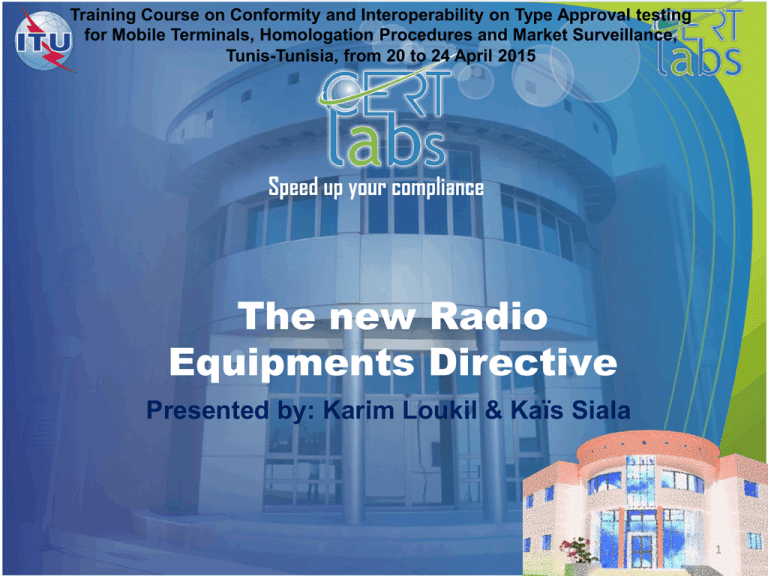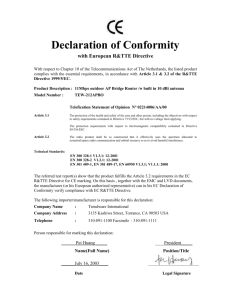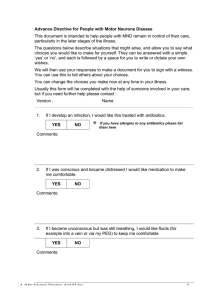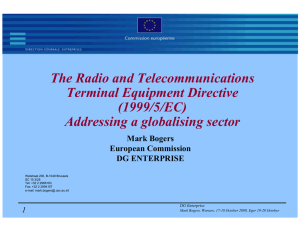Training Course on Conformity and Interoperability on Type Approval testing
advertisement

Training Course on Conformity and Interoperability on Type Approval testing for Mobile Terminals, Homologation Procedures and Market Surveillance, Tunis-Tunisia, from 20 to 24 April 2015 The new Radio Equipments Directive Presented by: Karim Loukil & Kaïs Siala 1 R&TTE directive (1999/5/CE) European Union Compliance • The need for CE Marking • New Approach Directives Eliminate differences in laws therefore remove technical barriers to trade Prescribe the Essential requirements for Health, Safety, .. Member states transpose directives and harmonized standards into their national requirements Third party intervention is not mandatory Manufacturer Self conformity Declaration Voluntary Use of Standards CE Label as the indication of compliance • CE marking process 3 Essential requirements • the requirements that products must meet to be put on the market. • They are mandatory. • They define the results to be attained, or the risks to be dealt with, but do not specify the technical solutions for doing so; • suppliers are free to choose how the requirements are to be met. 4 Typical products Typical products, which are covered by the R&TTE Directive, are: Radio terminals: GSM handsets. Other radio equipment: GSM base stations, car-door openers and other short range radio devices. Fixed network terminal equipment: normal analogue telephones, XDSL terminals, cable and PC modems. No more applicable in new Radio directive 5 Manufacturers declaration of Conformity • • Introduction of manufacturers' declaration of conformity Assessment of the conformity of a product with the requirements of the Directive is a responsibility for the manufacturer. No need to obtain an approval certificate from an official body after having passed tests in a legally recognized laboratory. 6 Minimum Requirements • Terminal access requirements have been removed: fixed network terminal equipment therefore only needs to comply with Health and Safety requirements: – Health : as per EMF recommandation 1999/519/CE – Safety : as per Directive 2006/95/CE (LVD) but with the lower limit removed. (Article 3.1) EMC requirements: as per Directive 2004/108/CE (Article 3.1) Radio equipment needs to effectively use the spectrum and not cause harmful interference. (Article 3.2) 7 Example: Bluetooth & Wifi Applied standards • • • • Radio : EN 300 328 + ERC 70-03 recommandation EMC : EN 301 489-17 & EN 301 489-01 Safety : EN 60950 Health : EN 50364 8 Equipment Class Identifiers Class 1: • Radio equipment and telecommunications terminal equipment which can be placed on the market and be put into service without restrictions. • This class will be referred to as “Class 1”. An Equipment Class Identifier is not defined for this class of equipment. 9 Equipment Class Identifiers Class 2: • R&TTE equipment for which Member States apply restrictions on the putting into service • or for which Member States apply restrictions on the placing on the market. • This class will be referred to as “Class 2”. The following Equipment Class Identifier or “ alert sign” is defined for equipment within this class: No more equipment class 2 notifications to national FSA in new Radio directive 10 Putting Into Market • Comply to essential requirements • Respect of the national requirements 11 Radio Equipments RE directive (2014/53/EU) New EU Legislation in 2014 • Electromagnetic Compatibility (EMC) Directive 2014/30/EU – OJ L96 29 March 2014 – Replaces 2004/108/EC • Low Voltage Directive 2014/35/EU – OJ L96 29 March 2014 – Replaces 2006/95/EC • Radio Equipment Directive 2014/53/EU – OJ L153 22 May 2014 – Replaces Radio & Telecommunication Terminal Equipment Directive (RTTED) 1999/5/EC 13 2014/53/EU: New elements • No need to cover wired terminal equipment, concentrate on radio equipment • Provisions for Universal Charger • Increased emphasis on efficient use of spectrum, in particular by improving radio receiver requirements • Clear scope (but still some boundaries re: purpose of spectrum use) • Improved provisions for market surveillance & enforcement (in particular between Member States) – Simplified marking requirements – Product registration can be introduced in cases of extensive noncompliance • Clear link with Radio Spectrum Decision • New provisions for software-defined radio 14 major changes (1) • RED only applies to wireless/radio products; wired Telecom Terminal Equipment (TTE) is not covered anymore • RED scope includes radio communication and also radio determination (RFID, radar, movement detect, etc.) equipment radio equipment not for communication or determination is not within the scope of the RED • Broadcast receivers now fall into the scope (actually they weren’t in R&TTE) major changes (2) • RX only (like GPS) devices remain in scope • No lower limit of the covered frequency range (for R&TTE lower limit was 9 kHz), upper limit remains at 3000GHz • Safety requirements now explicitly apply also for animal related equipment (was in R&TTE but not clear to many readers) • Evaluation kits are now excluded (no approval required under RED) major changes (3) • RED requires common / universal chargers • No more equipment class 2 notifications to national FSA • No more class 2 labelling (Alert Sign) • No more Notified Body number with CE mark for single product approvals • (Notified Body number only applies if the Quality System of the manufacturer was assessed against RED requirements (Full Quality Assurance – Module H)) • No more CE mark in the user manual • Notified Body Opinion will be replaced by “Type Examination Certificate” specific requirements • The new directive also introduces some new specific requirements: • ensure that software can only be used with radio equipment after the compliance of that particular combination of software and the radio equipment has been demonstrated; • the Commission will have the possibility to require that mobile phones and other portable devices are compatible with a common charger. EQUIPMENT NOT COVERED BY THIS DIRECTIVE (1) • 1. Radio equipment used by radio amateurs, unless the equipment is made available on the market: – Unless made available on the market • 2. Marine equipment. • 3. Airborne products, parts and appliances. • 4. Custom-built evaluation kits destined for professionals to be used solely at research and development facilities for such purposes. Essential requirements for all radio equipment • Art. 3.1(a): Safety requirements as LVD, but with no lower voltage limit • Art 3.1(b): EMC requirements as EMCD • Art 3.2: effective and efficient use of radio spectrum to avoid harmful interference • See recitals (10) & (11): aim to increase the resilience of receivers to ensure efficient use of spectrum in adjacent bands. 20 Art 3.3: Requirements to be invoked necessary a) Interworking with accessories, in particular common chargers b) Interworking via networks c) May be connected to interfaces of the appropriate type d) Shall not harm the network or misuse network resources e) Safeguards personal data & privacy f) Protection from fraud g) Access to emergency services h) Facilitates use by a person with a disability i) Can only load compliant software Commission may invoke the above requirements for certain equipment where via a delegated act 21 Use of radio frequencies: notified interfaces • Member states no longer required to notify interfaces which: a) Are covered by a Commission Decision under 676/2002/EC (Radio Spectrum Decision), or b) Correspond to a class of equivalent interfaces that can be used anywhere in the Union (specified via implementing act) • Manufacturers no longer required to inform Member State before placing on the market equipment that uses nonharmonised spectrum – Manufacturer to check in EFIS if frequencies are available – Frequency & power to be included in user instructions • No ‘Alert symbol’: 22 Access to market • Art 7: “Member States shall allow the putting into service and use of radio equipment if it complies with this Directive ...” • Art 16: “Radio equipment which is in conformity with harmonised standards ... shall be presumed to be in conformity with the essential requirements” • Art 17.3 allows the manufacturer to self-declare conformity (“Internal production control”) if he has applied harmonised standards. • Alternatives are available: “EU-type examination” or “conformity based on full quality assurance” both require use of a Notified Body • No specific provisions for “essential radio test suites” 23 Training Course on Conformity and Interoperability on Type Approval testing for Mobile Terminals, Homologation Procedures and Market Surveillance, Tunis-Tunisia, from 20 to 24 April 2015 Thank you Presented by: Karim Loukil & Kaïs Siala 24



